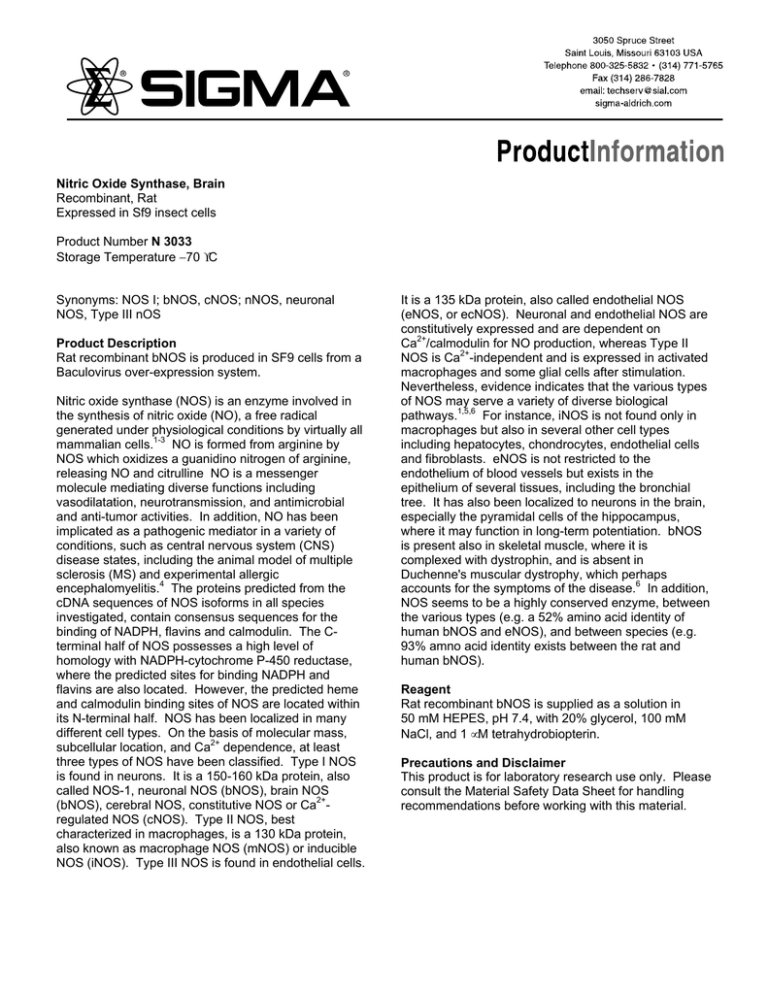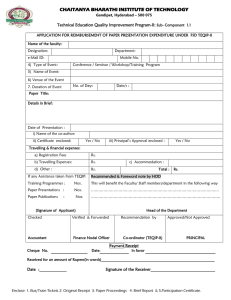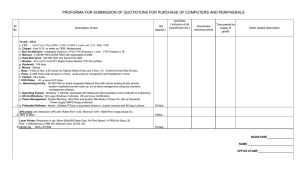Nitric Oxide Synthase, Neuronal from rat (N3033)
advertisement

Nitric Oxide Synthase, Brain Recombinant, Rat Expressed in Sf9 insect cells Product Number N 3033 Storage Temperature −70 °C Synonyms: NOS I; bNOS, cNOS; nNOS, neuronal NOS, Type III nOS Product Description Rat recombinant bNOS is produced in SF9 cells from a Baculovirus over-expression system. Nitric oxide synthase (NOS) is an enzyme involved in the synthesis of nitric oxide (NO), a free radical generated under physiological conditions by virtually all mammalian cells.1-3 NO is formed from arginine by NOS which oxidizes a guanidino nitrogen of arginine, releasing NO and citrulline NO is a messenger molecule mediating diverse functions including vasodilatation, neurotransmission, and antimicrobial and anti-tumor activities. In addition, NO has been implicated as a pathogenic mediator in a variety of conditions, such as central nervous system (CNS) disease states, including the animal model of multiple sclerosis (MS) and experimental allergic encephalomyelitis.4 The proteins predicted from the cDNA sequences of NOS isoforms in all species investigated, contain consensus sequences for the binding of NADPH, flavins and calmodulin. The Cterminal half of NOS possesses a high level of homology with NADPH-cytochrome P-450 reductase, where the predicted sites for binding NADPH and flavins are also located. However, the predicted heme and calmodulin binding sites of NOS are located within its N-terminal half. NOS has been localized in many different cell types. On the basis of molecular mass, subcellular location, and Ca2+ dependence, at least three types of NOS have been classified. Type I NOS is found in neurons. It is a 150-160 kDa protein, also called NOS-1, neuronal NOS (bNOS), brain NOS (bNOS), cerebral NOS, constitutive NOS or Ca2+regulated NOS (cNOS). Type II NOS, best characterized in macrophages, is a 130 kDa protein, also known as macrophage NOS (mNOS) or inducible NOS (iNOS). Type III NOS is found in endothelial cells. It is a 135 kDa protein, also called endothelial NOS (eNOS, or ecNOS). Neuronal and endothelial NOS are constitutively expressed and are dependent on Ca2+/calmodulin for NO production, whereas Type II NOS is Ca2+-independent and is expressed in activated macrophages and some glial cells after stimulation. Nevertheless, evidence indicates that the various types of NOS may serve a variety of diverse biological pathways.1,5,6 For instance, iNOS is not found only in macrophages but also in several other cell types including hepatocytes, chondrocytes, endothelial cells and fibroblasts. eNOS is not restricted to the endothelium of blood vessels but exists in the epithelium of several tissues, including the bronchial tree. It has also been localized to neurons in the brain, especially the pyramidal cells of the hippocampus, where it may function in long-term potentiation. bNOS is present also in skeletal muscle, where it is complexed with dystrophin, and is absent in Duchenne's muscular dystrophy, which perhaps accounts for the symptoms of the disease.6 In addition, NOS seems to be a highly conserved enzyme, between the various types (e.g. a 52% amino acid identity of human bNOS and eNOS), and between species (e.g. 93% amno acid identity exists between the rat and human bNOS). Reagent Rat recombinant bNOS is supplied as a solution in 50 mM HEPES, pH 7.4, with 20% glycerol, 100 mM NaCl, and 1 µM tetrahydrobiopterin. Precautions and Disclaimer This product is for laboratory research use only. Please consult the Material Safety Data Sheet for handling recommendations before working with this material. Storage/Stability Recombinant rat bNOS should be stored at or below −70 °C. The solution will be stable for at least 6 months at that temperature. The enzyme loses approximately 40% of its activity during a single freeze-thaw cycle. Therefore, after the initial defrost, it is recommended that the product be stored in single-use aliquots at −70 °C. During use, keep the solution on ice at all times since the enzyme is unstable at higher temperatures. Product Profile The activity of recombinant rat bNOS is determined by an oxyhemoglobin assay that measures the reaction of nitric oxide with oxyhemoglobin to yield methemoglobin.8 One unit of enzyme produces 1 nmole of nitric oxide per minute at 37 °C in 50 mM HEPES, pH 7.4, containing 5 µM oxyhemoglobin, 1 mM CaCl2, 20 µg/ml calmodulin, 0.1 mM NADPH, 50 µM arginine, 12 µM tetrahydrobiopterin, and 170 µM DTT. bNOS is calcium/ calmodulin dependent and has a Km for arginine of approximately 2 µM.7 Recombinant rat bNOS is a homodimer, each subunit of which has a molecular weight of approximately 150 kDa. Purity of the protein is >95% References 1. Dinerman, J.L., et al., Endothelial nitric oxide synthase localized to hippocampal pyramidal cells: implications for synaptic plasticity. Proc. Natl. Acad. Sci. USA, 91, 4214-4218 (1994). 2. Bredt, D.S., and Snyder, S.H., Isolation of nitric oxide synthetase, a calmodulin-requiring enzyme. Proc. Natl. Acad. Sci. USA, 87, 682-685 (1990). 3. Stuehr, J.J., and Griffiths, O.W., in: “Advances in Enzymology and Related Areas of Molecular Biology”, Meister, A., (Ed.), J. Wiley & Sons, New York, 65, 287, (1992). 4. Bagasra, O., et al., Activation of the inducible form of nitric oxide synthase in the brains of patients with multiple sclerosis. Proc. Natl. Acad. Sci. USA., 92, 12041-12045 (1995). 5. Snyder, S.H., Nature, Nitric oxide. More jobs for that molecule. 372, 504-505 (1994). 6. Snyder, S.H., Nitric oxide. No endothelial NO. Nature, 377, 196-197 (1995). 7. Richards, M.K., and Marletta, M.A., Characterization of neuronal nitric oxide synthase and a C415 mutant, purified from a baculovirus overexpression system. Biochemistry, 33, 14723−14732 (1994). 8. Hevel, J.M. and Marletta, M.A., Nitric-oxide synthase assays. Methods Enzymol., 233, 250−258 (1994). SLL 8/01 Sigma brand products are sold through Sigma-Aldrich, Inc. Sigma-Aldrich, Inc. warrants that its products conform to the information contained in this and other Sigma-Aldrich publications. Purchaser must determine the suitability of the product(s) for their particular use. Additional terms and conditions may apply. Please see reverse side of the invoice or packing slip.


